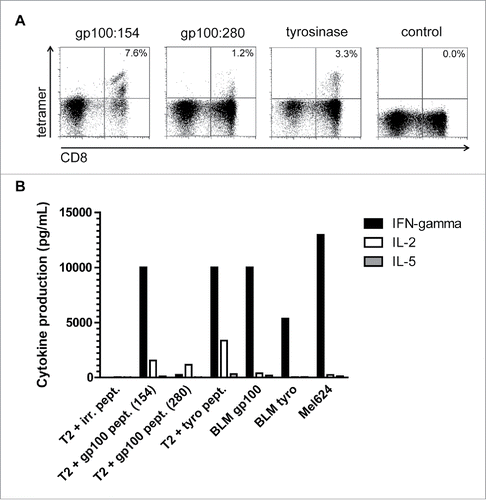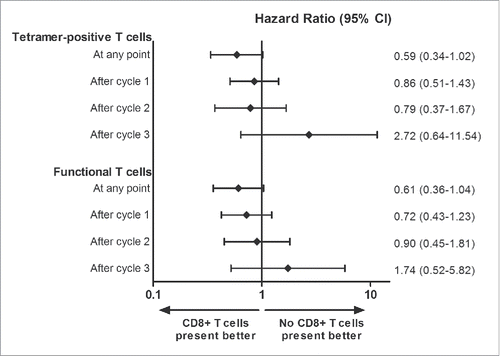Figures & data
Table 1. Baseline characteristics.
Figure 1. Tumor antigen-specific CD8+ (T)cell responses in SKIL cultures. An example is shown of a tetramer analysis of SKILs from patient II-D-12 (A). Cells were stained with tetramers encompassing the peptides gp100:154, gp100:280, tyrosinase or an irrelevant peptide (control) and with anti-CD8+ mAb. This analysis showes presence of TAA-specific CD8+ T cells against both gp100 epitopes and tyrosinase. Furthermore, a cytokine profile of the same T cells is shown after stimulation with T2 cells loaded with gp100 or tyrosinase peptide, BLM cells transfected with gp100 or tyrosinase, or MEL624 cells expressing both gp100 and tyrosinase (B). Functional TAA-specific T cells against gp100 and tyrosinase are present with a clear production of IFNγ and/or IL-2, but without IL-5 production.

Figure 2. SKILs analysis in time. Skin-test infiltrating lymphocytes from DTH skin-test biopsies were analyzed for the presence of tetramer-positive CD8+ T cells (A) and a functional T cell response against individual epitopes (B). Three epitopes were tested, gp100:154, gp100:280, and tyrosinase. Unfilled/filled circles represent negative/positive tests. The black, red, and blue circles match to the first, second, and third cycle of vaccinations, respectively. Tumor-specific T cells are already seen after the first cycle in a large amount of patients. T cells against other epitopes were detected in a proportion of patients after cycle 2 and 3. However, in some patients T cells against an epitope were not detected after a positive result in the previous cycle. This is more often seen for tetramer-positive T cells than for a functional T cell response. The distant metastasis-free survival (DMFS) of each individual patient is shown with a cut-off at 5 y. Arrows indicate an ongoing DMFS.

Figure 3. Analyses of distant metastasis-free survival. A graphical representation of the hazard ratios (HR) of distant metastasis-free survival (DMFS) comparing patients with or without tetramer-positive and a functional T cell response in DTH skin-test biopsies, using Cox proportional-hazard models. HR less than 1 defines a better DMFS for patients with tumor-specific T cells. Horizontal lines represent 95% confidence intervals. A trend for a lower risk of distant metastases is seen for patients with tetramer-positive T cells and a functional T cell response at any point during the vaccinations as compared with patients without a T cell response. However, conditional landmark analyses after cycle 1 (n = 97), cycle 2 (n = 72), and cycle 3 (n = 56) show no difference in risk of distant metastases between patients with or without tetramer-positive T cells and a functional T cell response.

Table 2. Dendritic cell vaccination protocols.
